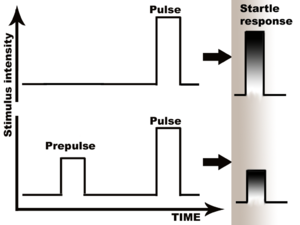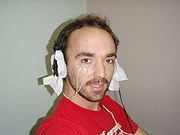
Prepulse inhibition
Encyclopedia

The reduction of the amplitude of startle reflects the ability of the nervous system to temporarily adapt to a strong sensory stimulus when a preceding weaker signal is given to warn the organism. PPI is detected in numerous species ranging from mice to human. Although the extent of the adaptation affects numerous systems, the most comfortable to measure are the muscular reactions, which are normally diminished as a result of the nervous inhibition.
Deficits of prepulse inhibition manifest in the inability to filter out the unnecessary information; they have been linked to abnormalities of sensorimotor gating. Such deficits are noted in patients suffering from illnesses like schizophrenia
Schizophrenia
Schizophrenia is a mental disorder characterized by a disintegration of thought processes and of emotional responsiveness. It most commonly manifests itself as auditory hallucinations, paranoid or bizarre delusions, or disorganized speech and thinking, and it is accompanied by significant social...
and Alzheimer’s disease, and in people under the influence of drugs, surgical manipulations, or mutations. Human studies of PPI have been summarised in reviews by Braff et al. (2001) and Swerdlow et al. (2008).
Procedure

With the interval exceeding 500 ms, prepulse facilitation - increased response - is most likely to follow.
Burst of white noise
White noise
White noise is a random signal with a flat power spectral density. In other words, the signal contains equal power within a fixed bandwidth at any center frequency...
is usually used as acoustic startle stimulus. Typical durations are 20 ms for prepulse and 40 ms for pulse. Background noise with 65-70 dB is used in human studies, and 30-40 dB in rodent experiments. Prepulse is typically set 3-12 dB louder than background. Startle response is measured in rodents using the so-called automated “startle chambers” or “stabilimeter chambers”, with detectors recording whole-body reaction.
In humans, the movements of oculomotor muscles (“eye-blink reflex” or “eye-blink response” assessed using electromyographic recording of orbicularis oculi muscle and by oculography) could be used as a measure.
Pulse-alone results are compared to prepulse-plus-pulse, and the percentage of the reduction in the startle reflex represents prepulse inhibition.
Possible hearing impairment must be taken into account, as, for example, several strains of mice develop high frequency hearing loss when they mature.
Major features
- The magnitude of PPI is often significant, reaching as much as 65% in healthy subjects.
- Maximum inhibition is typically observed at 120 ms interval.
- Baseline startle response does not affect overall PPI levels – this finding was first discovered in rat studies and later duplicated in the studies of mice.
- The opposite reaction, Prepulse Facilitation (PPF), is typically noted when the interval between stimuli lasts longer than 500 ms. PPF is thought to reflect, at least partially, sustained attention.
- There is noted sex difference in prepulse inhibition, with men having higher PPI, while women having higher PPF.
- Monaural PPI is higher than binaural.
- Even the very first prepulse of the test session induces inhibition, which indicates that conditioning and learning are not necessary for this effect to occur. However, the lack of conditionality has been questioned.
- It is thought that the short intervals used in PPI task do not give enough time for the activation of a volitionVolition (psychology)Volition or will is the cognitive process by which an individual decides on and commits to a particular course of action. It is defined as purposive striving, and is one of the primary human psychological functions...
al response. - Prepulses could be attended or ignored, and attention affects the outcome. In one study, normal college students were instructed to attend to one of the kind of prepulses, high- or low-pitched, and ignore the other. Attended prepulse caused significantly greater inhibition at the 120 ms interval compared to the ignored one, and significantly greater facilitation at the 2000 ms interval.
- Louder background noise increases the amplitude of the startle response.
- Increased prepulse duration leads to increase in PPI.
- Steady background noise facilitates the startle response, while pulsed background produces inhibition.
Disruption of PPI
Disruptions of PPI are studied in humans and many other species. The most studied are deficits of PPI in schizophrenia, although this disease is not the only one to cause such deficits. They have been noted in panic disorderPanic disorder
Panic disorder is an anxiety disorder characterized by recurring severe panic attacks. It may also include significant behavioral change lasting at least a month and of ongoing worry about the implications or concern about having other attacks. The latter are called anticipatory attacks...
(Ludewig, et al., 2005), schizotypal personality disorder
Schizotypal personality disorder
Schizotypal personality disorder, or simply schizotypal disorder, is a personality disorder that is characterized by a need for social isolation, anxiety in social situations, odd behavior and thinking, and often unconventional beliefs.-Genetic:...
, obsessive-compulsive disorder
Obsessive-compulsive disorder
Obsessive–compulsive disorder is an anxiety disorder characterized by intrusive thoughts that produce uneasiness, apprehension, fear, or worry, by repetitive behaviors aimed at reducing the associated anxiety, or by a combination of such obsessions and compulsions...
(Swerdlow et al., 1993), Huntington's disease
Huntington's disease
Huntington's disease, chorea, or disorder , is a neurodegenerative genetic disorder that affects muscle coordination and leads to cognitive decline and dementia. It typically becomes noticeable in middle age. HD is the most common genetic cause of abnormal involuntary writhing movements called chorea...
, nocturnal enuresis and attention deficit disorder (Ornitz et al. 1992), and Tourette's syndrome (Swerdlow et al. 1994; Castellanos et al. 1996). According to one study, people who have temporal lobe epilepsy
Temporal lobe epilepsy
Temporal lobe epilepsy a.k.a. Psychomotor epilepsy, is a form of focal epilepsy, a chronic neurological condition characterized by recurrent seizures. Over 40 types of epilepsies are known. They fall into two main categories: partial-onset epilepsies and generalized-onset epilepsies...
with psychosis
Psychosis
Psychosis means abnormal condition of the mind, and is a generic psychiatric term for a mental state often described as involving a "loss of contact with reality"...
also show decreases in PPI, unlike those who have TLE without psychosis. Therefore, PPI deficits are not typical to specific disease, but rather tell of disruptions in a specific brain circuit.
PPI deficit in schizophrenia
PPI deficits represent a well-described finding in schizophreniaSchizophrenia
Schizophrenia is a mental disorder characterized by a disintegration of thought processes and of emotional responsiveness. It most commonly manifests itself as auditory hallucinations, paranoid or bizarre delusions, or disorganized speech and thinking, and it is accompanied by significant social...
, with the first report dating back to 1978. The abnormalities are also noted in unaffected relatives of the patients. In one study, patients failed to show increased PPI to attended prepulses. Dopamine
Dopamine
Dopamine is a catecholamine neurotransmitter present in a wide variety of animals, including both vertebrates and invertebrates. In the brain, this substituted phenethylamine functions as a neurotransmitter, activating the five known types of dopamine receptors—D1, D2, D3, D4, and D5—and their...
, which plays a major role in schizophrenia, had been shown to regulate sensorimotor gating in rodent models. These findings fit to the dopamine hypothesis of schizophrenia
Dopamine hypothesis of schizophrenia
The dopamine hypothesis of schizophrenia or the dopamine hypothesis of psychosis is a model attributing symptoms of schizophrenia to a disturbed and hyperactive dopaminergic signal transduction. The model draws evidence from the observation that a large number of antipsychotics have...
. In theory, PPI disruption in schizophrenia may be related to the processes of sensory flooding and cognitive fragmentation.
Antipsychotic medication have been shown to increase PPI in patients, with atypical antipsychotics having more effect. Patients display the same gender difference in PPI as healthy people: males have higher PPI compared to females. One notable finding is that patients are specifically deficient in PPI with 60 ms prepulse intervals relative to intervals of other lengths; this remains so even under antipsychotic treatment.
The other fact is the influence of cigarette smoking. Non-smoking patients have lower PPI compared to smokers, and heavy smokers have the highest PPI. This finding runs in accord with the high rates of smoking among schizophrenic patients, estimated at 70%, with many patients smoking more than 30 cigarettes a day. Thus, smoking may be a way of self-medication. Some studies show association of schizophrenia with the CHRNA7
CHRNA7
Neuronal acetylcholine receptor subunit alpha-7 is a protein that in humans is encoded by the CHRNA7 gene.-See also:* Alpha-7 nicotinic receptor* Nicotinic acetylcholine receptor* Acetylcholine receptor...
and CHRFAM7A
CHRFAM7A
HTTP/1.0 200 OKDate: Mon, 26 Sep 2011 22:44:26 GMTServer: ApacheCache-Control: public, s-maxage=0, max-age=2678400Last-Modified: Mon, 28 Jun 2010 23:21:29 GMTVary: Accept-EncodingContent-Length: 5944Content-Type: text/x-wiki; charset=UTF-8...
genes, which code for alpha7 subunit of nicotinic receptors, but other studies are negative. Contrary to the predictions, nicotine receptor alpha7 subunit knockout mice do not show disruptions in PPI.
Disruption of PPI in rodents
Murine models are widely used to test hypotheses linking genetic components of various diseases with sensorimotor gating. While some of the hypotheses stand to the test, others are not, as some mice models show unchanged or increased PPI contrary to the expectations, as in the tests of COMT-deficient mice.Certain surgical procedures also disrupt PPI in animals, helping to unravel the underlying circuitry.
Many animal studies of PPI are undertaken in order to understand and model the pathology of schizophrenia. Schizophrenia-like PPI disruption techniques in rodents have been classified in one review into four models:
- PPI impairment driven by dopamineDopamineDopamine is a catecholamine neurotransmitter present in a wide variety of animals, including both vertebrates and invertebrates. In the brain, this substituted phenethylamine functions as a neurotransmitter, activating the five known types of dopamine receptors—D1, D2, D3, D4, and D5—and their...
-receptor agonists, most validated for antipsychoticAntipsychoticAn antipsychotic is a tranquilizing psychiatric medication primarily used to manage psychosis , particularly in schizophrenia and bipolar disorder. A first generation of antipsychotics, known as typical antipsychotics, was discovered in the 1950s...
studies; - PPI impairment by 5-HT2 receptor5-HT2 receptorThe 5-HT2 receptors are a subfamily of 5-HT receptors that bind the endogenous neurotransmitter serotonin . The 5-HT2 subfamily consists of three G protein-coupled receptors which are coupled to Gq/G11 and mediate excitatory neurotransmission, including 5-HT2A, 5-HT2B, and 5-HT2C...
agonists; - PPI impairment by NMDAR antagonists;
- PPI impairment by developmental intervention (isolation rearing, maternal deprivation).
Diverse chemical compounds are tested on animals with such deficits. Compounds that are able to restore PPI could be further investigated for their potential antipsychotic role.
An updated summary of both preclinical and clinical findings with PPI can be found in a recent comprehensive review.
External links
- Table listing the action of different chemical compounds on PPI in mice - from the review by Geyer et al., 2002
- Losing Your (Prepulse) Inhibitions—All About α3 GABAA? - Schizophrenia Research Forum
- Prepulse Inhibition Deficits Predict Functional Difficulties in Schizophrenia - Schizophrenia Research Forum
- An Analysis of Nicotine Exacerbation of Reductions in PPI in a Rodent Model of Schizophrenia - a master's thesis with a thorough review of schizophrenia PPI disruption models in rodents

